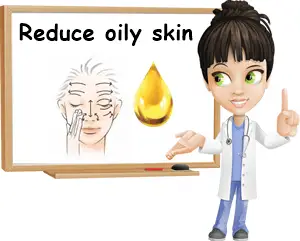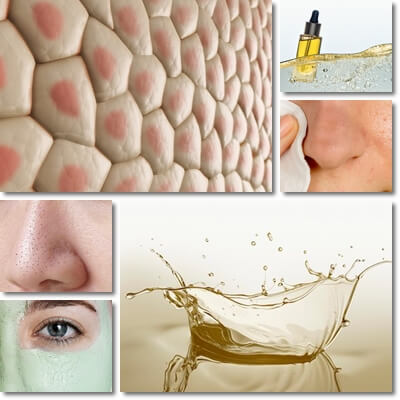Oily skin is a natural type of skin characterized by a higher production of sebum by the sebaceous glands compared to other skin types. It can be difficult to care for, but only becomes problematic when there is simply too much sebum being produced. Irrespective of how oily your skin is, you cannot exactly get rid of it because that is how it naturally is. What you can do instead is reduce sebum production for a less greasy appearance and learn to control shine as well as prevent, to a certain extent, acne and related skin problems. And in order to understand how to care for and have less of an oily skin, we must first understand what causes the excess sebum.
What causes excessively oily skin? For the most part, genetics and levels of certain hormones as well as life events that are characterized by fluctuating hormone levels, such as pregnancy, are the two major causes of oily skin. Diet and its impact on the endocrine system also contribute to excess sebum. The next equally important cause is lack of proper care often stemming from a lack of knowledge on how to care for your skin type properly. Because, believe it or not, some of the best oily skin advice are counter-intuitive. Here are the steps on how to have less oily skin.

Step 1: Exfoliate. By exfoliating the skin periodically you help remove old skin cells and allow new skin cells to take their place. This is a vital step for reducing oily skin problems because accumulation of sebum, old skin cells as well as dust, dirt and other particles trapped in pores promotes bacterial growth and can lead to acne, subsequent scars, blemishes or sensitization of skin. Exfoliation further helps unclog pores, remove blackheads and leaves the skin soft. Not to mention that by exfoliating you get to a fresh layer of skin that is more responsive to moisturizing. It helps to exfoliate at least two times a week, but some people with excessively oily skin may benefit from exfoliating three times a week.
While there are so many great products out there, a lot of them contain micro-beads which are harmful for the environment. Fortunately you can get excellent results by using products in your pantry such as sugar or salt. In my opinion, sugar is better because salt may cause a slight irritation of the skin should the exfoliation be too much at times. You can use it plain or combine it with other ingredients for various benefits, but keep in mind that ingredients you may use should provide gentle care and nourishment and not be harsh on the skin.
For example, a great face scrub can be obtained by mixing 1 tablespoon of sugar with 1 tablespoon of honey. Gently apply the product on a clean face and massage with the utmost care so as to not hurt the skin. Face exfoliation should always be done extremely careful because even the slightest pressure is enough to remove old skin cells and debris. More than this results in skin damage. If you’d like your face scrub to have a slight lightening effect in case you have uneven skin tone, I enjoyed good results when using a light-colored honey such as acacia honey (see other honey varieties). The benefit of using honey is that it has an acidic pH which deters bacteria growth, antimicrobial constituents, trace amounts of micronutrients which nourish the skin while the natural sugars help retain moisture. As soon as you’re done exfoliating, wash the face with warm water.

Step 2: Gentle face and body wash. A lot of people with oily skin make the mistake of using harsh products on their skin. They assume that all the excess sebum is removed when the skin feels almost dry and that harsh face and body washes are the only ones that can accomplish this. This is actually not a good approach because you want to work with your skin, not against it. Exfoliating removes old skin cells and other debris as well as excess surface sebum. Washes have to be gentle and only clean what may be left on the surface of the skin.
Harsh products dry the skin which is unnatural and can trigger the exact opposite reaction we want: more sebum. Remember that sebum has a protective role. Washing is only a form of maintenance of the skin, removing sweat and excess surface sebum which may feed bacteria populations and lead to acne and infections. But sebum needs to be produced to keep skin healthy.
Step 3: Moisturize. Freshly exfoliated skin absolutely requires moisturizing. A lightweight body lotion is great for providing moisture without leaving an oily film. Personally, I find that olive oil makes an excellent natural moisturizer even for oily skin. Applied on a clean, dry skin, it provides long-lasting, natural hydration and feeds the skin healthy unsaturated fatty acids such as Omega-3, with both antioxidant and anti-inflammatory properties. A water-based serum, preferably with collagen and vitamins such as vitamin C, vitamin E or vitamin A, followed by a lightweight face cream are a must following exfoliation.
Moisturizing after you’re removed sebum from the surface of the skin helps to balance the skin’s own oil production. Essentially the skin will respond by producing significantly less sebum. It’s also vital that you use high-quality serums and face creams, preferably enriched with nutrients, because the newly exfoliated skin is highly responsive to the nutrition and hydration it receives and will absorb everything faster because the old cells on the surface were removed and the pores cleaned.
Step 4: Intensive care. This is not done everyday, but periodically to build a healthy skin. For the oily skin types which produce a lot of sebum, water-based serums containing collagen, hyaluronic acid and vitamins C, E and A are ideal choices to provide intensive hydration without leaving a greasy finish. These can be applied 2-3 times a day, after cleaning the face. Alternatively, other oil-free skin care products may be used. For oily skin types that do not produce quite as much sebum as well as mixed types, you can use both water-based serums like those mentioned above and an oil-free, lightweight, intense moisturizing face cream.
Of course, face creams are best applied in small amounts after cleaning or exfoliating, then allowed to be absorbed and only reapplied if skin still feels dry. This is done in the morning and before going to sleep. Natural oils can be used in the same way. Even oils as simple as olive oil can have an intense hydrating effect as well as help nourish the skin, reduce inflammation and help it regenerate. As little as 2-3 drops of oil may be needed. The best time to use olive oil is at night, leaving the oil overnight to produce its effects and resuming normal skin care routine the next morning. But because not all oils are suited for every skin, you will have to choose the right one for you based on your skin’s individual response to it.
Step 5: Other advice for oily skin management.
1) Clean and hydrate your skin every morning and evening before going to sleep.
This is essential for reducing sebum production, preventing sebum buildup, acne and other problems.
2) Your towels are your own. Don’t share.
3) Change pillowcase 2-3 times a week.
4) Wash hair 2-3 times a week to prevent the dirt it accumulates to clog pores.
5) Wash pillowcase and towels in hot water, at 90 degrees Celsius to eliminate bacteria.
6) Avoid touching your face. Chances are it will turn into a habit which may undermine your efforts to keep acne breakouts under control.
7) Drink plenty of water to help hydrate the skin from within.
8) Eat food you prepare yourself from fresh ingredients and avoid anything processed as much as possible. Include healthy fats in your diet from nuts and seeds, eat plenty of fruits and vegetables and foods rich in vitamins A, C, D, E and B complex vitamins.
What you will observe after as little as one week:
1) Your skin will become less oily as the sebum production is balanced according to the moisture it receives through your skin care routine. Consequently, your skin will produce less oil.
2) You can better control shine and makeup will last longer and look better.
3) Acne will dry naturally, reduce in severity and breakouts will occur less frequently.
4) Pores will have a better appearance, look cleaner and be less visible.
5) Skin will be softer, better hydrated, more luminous and less uneven-colored.
Conclusion
For the most part, excess sebum is produced in oily skin when the skin care routine is incorrect. A lot of people wrongfully assume that if they have greasy skin, they don’t need to moisturize it. But if you remove the natural oils without replenishing them, then the more sebum your skin will produce in response and the greasier it will be. The key to having less oily skin is to up your skin care routine to provide intense hydration with the help of concentrated serums with collagen, hyaluronic acid and vitamins A, C and E, oil-free moisturizing creams, lightweight lotions and the occasional natural oils intensive treatment, along with regular exfoliation and good hygiene.
